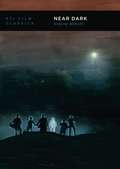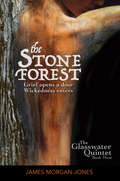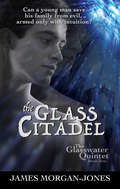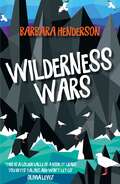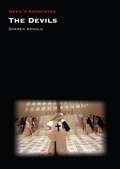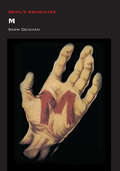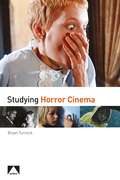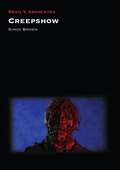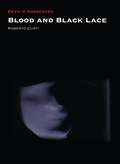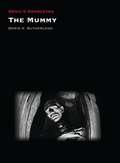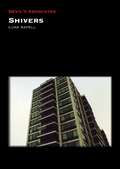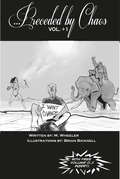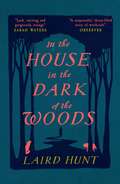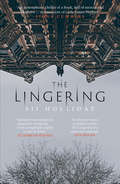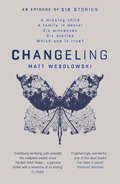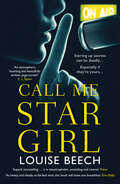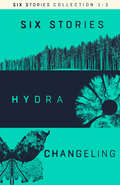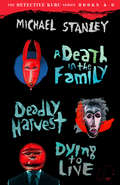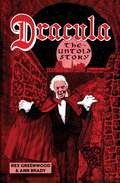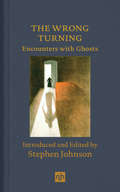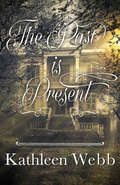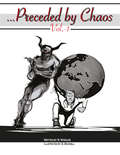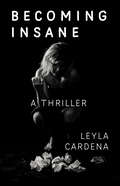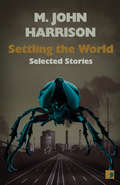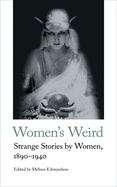- Table View
- List View
Near Dark (BFI Film Classics)
by Stacey AbbottFirst released in 1987, Near Dark is a vampire film set in the contemporary American Midwest that tells the story of Caleb, a half-vampire trying to decide whether to embrace his vampire nature or return to his human family. The film, an early work of the now-established director Kathryn Bigelow, skilfully mixes genre conventions, combining gothic tropes with those of the Western, road movie and film noir, while also introducing elements of the outlaw romance genre.Stacey Abbott's study of the film addresses it as a genre hybrid that also challenges conventions of the vampire film. The vampires are morally ambiguous and undermine the class structures that have historically defined stories of the undead. These are not aristocrats but instead they capture the allure and horror of the disenfranchised and the underclass. As Abbott describes, Near Dark was crucial in consolidating Bigelow's standing as a director of significance at an early point in her career, not simply because of her visual art background, but because of the way in which she would from Near Dark onward re-envision other traditionally mainstream genres of filmmaking.
The Stone Forest (The Glasswater Quintet #3)
by James Morgan-JonesThe 1930s are drawing to a close. On the brink of adulthood, Phyl discovers the Creek, an isolated community stranded between the Essex marshlands and the industrial highway of the Thames, where her life is unexpectedly enriched. But in the aftermath of life-changing illness and the traumatic loss of a friend, Phyl and her sister find themselves abruptly relocated to rural Wales where it is soon clear that the spectre of grief has not released its grip on her. Following the discovery of a cryptic set of verses and haunted by the foreboding figure of a man she does not know, Phyl is compelled both to unravel the strands of past tragedy and to confront an ever more implacable present as malevolent forces gather, threatening to destroy not only her fragile happiness but her very existence.
The Glass Citadel (The Glasswater Quintet #2)
by James Morgan-JonesIn its frosted chambers, everyone is alone An abducted psychic reads the cards to preserve her sanity. In another part of the country, struggling to keep his family from disintegration and to deflect the lethal attentions of an East End gang, Luke is forced to flee his home. In the long hot summer of 1976, these two strangers are connected in a way neither of them understands. Yet, as mounting obsession and the pursuit of violent revenge send events spiralling out of control, it becomes clear that their lives depend on a mutually-powered drive to prevail. The cards offer both a line of communication and a tantalising hint at salvation: Luke and Paige need to rely not only on their wits but on symbiotic faith and vision. Can the intangible ever be strong enough to deliver them - and those closest to them - from the forces of destruction?
Wilderness Wars
by Barbara HendersonWhat if nature fights back? In a daze, I take it all in: the wind, the leaden skies, the churning moody sea. And, far in the distance, a misty outline. Skelsay. Wilderness haven. Building-site. Luxury-retreat-to-be. And now, home. When her father’s construction work takes Em’s family to the uninhabited island of Skelsay, she is excited, but also a little uneasy. Soon Em and her friend Zac realise that the setbacks, mishaps and accidents on the island point to something altogether more sinister: the wilderness all around them has declared war. Danger lurks everywhere. But can Em and Zac persuade the adults to believe it before it’s too late?
The Devils (Devil's Advocates)
by Darren ArnoldUndoubtedly the most notorious title in director Ken Russell’s controversial filmography, The Devils (1973) caused a real furor on its initial theatrical release, only to largely disappear for many years. This Devil’s Advocate considers the film’s historical context, as the timing of the first appearance of The Devils is of particular importance, its authorship and adaptation (Russell’s auteur reputation aside, the screenplay is based on John Whiting’s 1961 play of the same name, which was in turn based on Aldous Huxley’s 1952 book The Devils of Loudun), and its generic hybridity. Darren Arnold goes on to examine the themes prevalent in the film—this is the only film of Russell’s which the director considered to be political—and considers the representation of gender and sexuality, gender fluidity, and how sex and religion clash to interesting and controversial effect. He concludes by revisiting the film’s censorship travails and the various versions of The Devils that have appeared on both big and small screens, and the film’s legacy and influence.
M (Devil's Advocates)
by Samm DeighanFritz Lang’s first sound feature, M (1931), is one of the earliest serial killer films in cinema history and laid the foundation for future horror movies and thrillers, particularly those with a disturbed killer as protagonist. Peter Lorre’s child killer, Hans Beckert, is presented as monstrous, yet sympathetic, building on themes presented in the earlier German Expressionist horror films like The Cabinet of Dr. Caligari and The Hands of Orlac. Lang eerily foreshadowed the rising fascist horrors in German society, and transforms his cinematic Berlin into a place of urban terror and paranoia. Samm Deighan explores the way Lang uses horror and thriller tropes in M, particularly in terms of how it functions as a bridge between German Expressionism and Hollywood’s growing fixation on sympathetic killers in the ‘40s. The book also examines how Lang made use of developments within in forensic science and the criminal justice system to portray a somewhat realistic serial killer on screen for the first time, at once capturing how society in the ‘30s and ‘40s viewed such individuals and their crimes and shaping how they would be portrayed on screen in the horror films to come.
Studying Horror Cinema (Auteur)
by Bryan TurnockAimed at teachers and students new to the subject, Studying Horror Cinema is a comprehensive survey of the genre from silent cinema to its twenty-first century resurgence. Structured as a series of thirteen case studies of easily accessible films, it covers the historical, production, and cultural context of each film, together with detailed textual analysis of key sequences. Sitting alongside such acknowledged classics as Psycho and Rosemary’s Baby are analyses of influential non-English language films as Kwaidan, Bay of Blood, and Let the Right One In. The author concludes with a chapter on 2017’s blockbuster It, the most financially successful horror film of all time, making Studying Horror Cinema the most up-to-date overview of the genre available.
Creepshow (Devil's Advocates)
by Simon BrownReleased in cinemas in 1982, Creepshow is typically regarded as a minor entry in both the film output of George A. Romero and the history of adaptations of the works of Stephen King. Yet this lack of critical attention hides the fact that Creepshow is the only full collaboration between America’s bestselling author of horror tales and one of the masters of modern American horror cinema. Long considered too mainstream for the director of Dawn of the Dead (1978), too comic for the author that gave audiences the film versions of Carrie (1976) and The Shining (1980), and too violent for a cinemagoing public turning away from gore cinema in the autumn of 1982, Creepshow is here reassessed by Simon Brown, who examines the making and release of the film and its legacy through a comic book adaptation and two sequels. His analysis focuses on the key influences on the film, not just Romero and King, but also the anthology horrors of Amicus Productions, body horror cinema, and the special make up effects of Tom Savini, the relationship between horror and humor, and most notably the tradition of EC horror comics of the 1950s, from which the film draws both its thematic preoccupations and its visual style. Ultimately the book argues that not only is Creepshow a major work in the canons of Romero and King, but also that it represents a significant example of the portmanteau horror film, of the blending of horror and comedy, and finally, decades before the career of Zack Snyder (Watchmen, Man of Steel), of attempting to recreate a comic book aesthetic on the big screen.
Blood and Black Lace (Devil's Advocates)
by Roberto CurtiMario Bava’s Blood and Black Lace (1964) is a legendary title, and is commonly considered as the archetypal giallo. A murder mystery about a faceless and menacing killer stalking the premises of a luxurious fashion house in Rome, Blood and Black Lace set the rules for the genre: a masked, black-gloved killer, an emphasis on graphic violence, elaborate and suspenseful murder sequences. But Blood and Black Lace is first and foremost an exquisitely stylish film, full of gorgeous color schemes, elegant camerawork, and surrealistic imagery, testimony of Bava’s mastery and his status as an innovator within popular cinema. This book recollects Blood and Black Lace’s production history, putting it within the context of the Italian film industry of the period and includes plenty of previously unheard-of data. It analyzes its main narrative and stylistic aspects, including the groundbreaking prominence of violence and sadism and its use of color and lighting, as well as Bava’s irreverent approach to genre filmmaking and clever handling of the audience’s expectations by way of irony and pitch-black humor. The book also analyzes Blood and Black Lace’s place within Bava’s oeuvre, its historical impact on the giallo genre, and its influential status on future filmmakers.
The Mummy (Devil's Advocates)
by Doris V. SutherlandReleased in 1932, The Mummy moved Universal horror away from the Gothic Europe of Dracula and Frankenstein and into a land of deserts, pyramids, and long-lost tombs. In doing so the film continued a tradition of horror fiction that is almost as old as the Western pursuit of Egyptology, as numerous European and American authors from the nineteenth and early twentieth centuries had portrayed Egypt as a place of mystery and magic. This book examines the roots of The Mummy. It shows how the film shares many of its motifs with the work of writers such as Bram Stoker, Arthur Conan Doyle, and H. Rider Haggard, whose tales of living mummies, immortal sorcerers, and Egyptian mysticism bear strong resemblances to Universal’s movie. In addition, the book discusses how The Mummy drew upon a contemporary vogue for all things ancient Egyptian: the tomb of Tutankhamun was discovered the decade before the film was released, prompting sensationalistic rumors of a curse. This is the story of what happened when Hollywood horror went to Egypt.
Shivers (Devil's Advocates)
by Luke AspellShivers (1975) was David Cronenberg’s first commercial feature and his first horror film. In a modern apartment block, a scientific project to unleash the id results in the equation of passion with contagion and predation. Because the writer-director’s imaginative landscape arrived in the genre fully formed, the unique forms of this début have often been overlooked or mistaken for shortcomings. Cronenberg’s most comedic film until Map to the Stars, Shivers is also his most spectacularly unnerving, throwing more images of extreme behavior at us than any of his subsequent films; it remains, with Crash, his most disquieting and transgressive film to date. Luke Aspell’s analysis addresses all channels of communication available to the 35mm sync-sound narrative feature, including shot composition, lighting, cinematographic texture, sound, the use of stock music, editing, costume, makeup, optical work, the screenplay, the casting, and the direction of the actors. Attending to form the better to see the film in its context, this tour of Shivers as “cognitive territory” takes in architecture, cultural context, critical reception, and artistic legacy.
...Preceded by Chaos: Vol.+1 (...Preceded by Chaos #2)
by M. WheelerThe protagonist, Mitchell Weaver, is a young Emergency Medicine doctor. Mitchell has entered a high stress, distinguished profession with the burden of a variety of particularly disturbing personal demons that he must battle every day in order to maintain the façade of sanity and control. The second installment of the series, Volume +1, documents Mitchell's state of mind as he tries his hand at decency and sobriety. Whether he finds himself at his job in New York or volunteering in the Dominican Republic, he struggles to suppress hedonistic urges and restructure awed philosophies. Although his attempts to gain control of his life are genuine, the question remains, "Is Mitchell gradually gaining control or is his life slowly falling apart."
In the House in the Dark of the Woods
by Laird HuntA dark fairytale, full of witchcraft, where nothing is as it seemsOnce upon a time there was and there wasn't a woman who went to the woods.In this dark fairy tale, a young woman sets off to pick berries in the depths of the forest, but can't find her way home again. Or perhaps she has fled or abandoned her family. Or perhaps she's been kidnapped, and set loose to wander in the wilderness. Alone and possibly lost, she meets another woman who offers her help. Then everything changes.On a journey that will take her to the depths of the witch-haunted woods, through a deep well wet with the screams of men, and on a living ship made of human bones, our heroine may find that the evil she flees has been inside her all along.Laird Huntis an American writer and translator. He has written seven novels, including Neverhome, which was a New York Times Book Review Editor's Choice selection, an IndieNext selection, winner of the Grand Prix de Littérature Américaine and The Bridge prize, and a finalist for the Prix Femina Étranger. His In the House in the Dark of the Woods is also available from Pushkin Press. A resident of Boulder, CO, he is on the faculty in the creative writing PhD program at the University of Denver.
The Lingering
by SJI HollidayA twisty, chilling psychological thriller cum gothic ghost story set in a Victorian psychiatric home with a disturbing history, and someone set on revenge…LONGLISTED for the Guardian’s Not the Booker PrizeNumber One Bestseller in Ebook’Cements Holliday’s position as one of the most gifted and entertaining psychological thriller writers in the business’ Steve Cavanagh‘Saunters from creepy to genuinely terrifying … I was completely unable to put it down’ Elizabeth Haynes‘In the new wave of gothic novels, The Lingering is a stand-out triumph’ Eva Dolan‘An atmospheric chiller of a book … reminiscent of early James Herbert’ Fiona CumminsMarried couple Jack and Ali Gardiner move to a self-sufficient commune in the English Fens, desperate for fresh start. The local village is known for the witches who once resided there and Rosalind House, where the commune has been established, is a former psychiatric home, with a disturbing history.When Jack and Ali arrive, a chain of unexpected and unexplained events is set off, and it becomes clear that they are not all that they seem. As the residents become twitchy, and the villagers suspicious, events from the past come back to haunt them, and someone is seeking retribution…At once an unnerving mystery, a chilling thriller and a dark and superbly wrought ghost story, The Lingering is an exceptionally plotted, terrifying and tantalisingly twisted novel by one of the most exciting authors in the genre.'Utterly beguiling and darkly sinister, this superb Gothic ghost tale is a brilliantly crafted rug puller’ Lisa Howells, Heat Magazine‘A wonderful cross-over novel that ranges from taut psychological chiller to supernatural suspense … Nail-biting stuff, superbly executed’ Sunday Times‘Readers will find this contemporary gothic tale hard to put down’ Publishers Weekly‘A thrilling, chilling, shocking tale, perfect if you take delight in an icy shiver scuttling down your spine’ LoveReading‘Brilliantly chilling and perfectly paced’ Anna Mazzola‘One of the most original ghost stories I have ever read’ Cass Green‘Like Stephen King meets Thomas Harris’ Derek Farrell‘A serious spine-chiller from an exceptional talent’ Chris Whitaker‘Tense and chilling, with a creeping sense of unease’ Neil Broadfoot‘Perfectly paced and guaranteed to cause you sleepless nights for all the right reasons. Fans of Susan Hill and Andrew Taylor, take note’ David Mark‘Creepy, unsettling and all-consuming’ Jenny Blackhurst‘Spooky, compelling and chilling’ Jane Isaac‘Eerie and unsettling, with a bittersweet beauty’ Fergus McNeill‘Unnerved me right from the start’ June Taylor’A perfect winter read’ Lisa Gray‘An unsettling tale of haunting … that lingers in the mind’ Mason Cross‘A relentlessly unnerving mystery – like shuffling footsteps from a long-locked attic’ Matt Wesolowski‘Gets under your skin and stays there’ Quentin Bates‘The story is at the same time a locked room mystery, a chilling thriller and a dark and complex ghost story which has been described as both creepy and chilling’ Mystery People
Changeling (Six Stories)
by Matt WesolowskiLONGLISTED for the Theakston Old Peculier Crime Novel of the YearSHORTLISTED for Best Thriller at the Amazon Publishing Readers’ Awards 2019SHORTLISTED for Best Independent Voice at the Amazon Publishing Readers’ Awards 2019Elusive online journalist Scott King investigates another cold case – the disappearance of seven-year-old Alfie – in an intensely dark, deeply chilling and searingly thought-provoking thriller … for fans of Serial‘Insidiously terrifying, with possibly the creepiest woods since The Blair Witch Project … a genuine chiller with a whammy of an ending’ C J Tudor‘Frighteningly wonderful … one of the best books I’ve read in years’ Khurrum Rahman’A creepy, chilling read that is ridiculously difficult to put down’ Luca VesteA missing childA family in denialSix witnessesSix storiesWhich one is true?On Christmas Eve in 1988, seven-year-old Alfie Marsden vanished in the dark Wentshire Forest Pass, when his father, Sorrel, stopped the car to investigate a mysterious knocking sound. No trace of the child, nor his remains, have ever been found. Alfie Marsden was declared officially dead in 1995.Elusive online journalist, Scott King, whose ‘Six Stories’ podcasts have become an internet sensation, investigates the disappearance, interviewing six witnesses, including Sorrel and his ex-partner, to try to find out what really happened that fateful night. Journeying through the trees of the Wentshire Forest – a place synonymous with strange sightings, and tales of hidden folk who dwell there, he talks to a company that tried and failed to build a development in the forest, and a psychic who claims to know what happened to the little boy…Intensely dark, deeply chilling and searingly thought provoking, Changeling is an up-to-the-minute, startling thriller, taking you to places you will never, ever forget.‘Wonderfully horrifying … the suspense crackles’ James Oswald‘Original, inventive and dazzlingly clever’ Fiona Cummins‘A complex and subtle mystery, unfolding like dark origami to reveal the black heart inside’ Michael Marshall Smith‘First-class plotting’ S Magazine‘A dazzling fictional mystery’ Foreword Reviews‘Readers of Kathleen Barber’s Are You Sleeping and fans of Ruth Ware will enjoy this slim but compelling novel’ Booklist‘Haunting, horrifying, and heartrending. Fans of Arthur Machen, whose unsettling tale The White People provides an epigraph, will want to check this one out’ Publishers Weekly‘For those who like the book they curl up with in their favourite slipper socks to generate a powerful sense of unease, and impel them to check all doors are locked and as many lights turned on as possible, Matt Wesolowski has just the formula to meet your self-scaring needs… ‘ Strong Words magazine‘A masterly piece of storytelling, very sinister, deliciously entertaining’ New Books Magazine‘The ending packed a real punch. Changeling continues a series which just keeps on getting better and better, it surprises, thrills and enthrals in equal measure’ LoveReading'I found myself gripping the pages tightly as I read’ Off-the-Shelf Books‘Ingenious’ Espresso Coco‘A chilling read, a sinister story and the best Six Stories yet’ The Tattooed Book Geek
Call Me Star Girl
by Louise BeechA taut, emotive, devastating dark and all-consuming psychological thriller, reminiscent of Play Misty for Me … from the critically acclaimed author of Maria in the Moon and The Lion Tamer Who Lost…WINNER of Best magazine’s BIG Book of the Year 2019LONGLISTED for Guardian‘s NOT THE BOOKER PRIZE'A complex and layered tale that charmed me as a much as it traumatised me. An atmospheric, haunting and beautifully written page turner!’ C L Taylor‘Noirish psychological thriller with fascinating, disturbing characters. Compelling, twisty, and seriously addictive. EXCELLENT’ Will Dean'As twisty and deadly as barbed wire, this book will leave you breathless’ Erin KellyStirring up secrets can be deadly … especially if they’re yours…Pregnant Victoria Valbon was brutally murdered in an alley three weeks ago – and her killer hasn’t been caught.Tonight is Stella McKeever’s final radio show. The theme is secrets. You tell her yours, and she’ll share some of hers.Stella might tell you about Tom, a boyfriend who likes to play games, about the mother who abandoned her, now back after fourteen years. She might tell you about the perfume bottle with the star-shaped stopper, or about her father …What Stella really wants to know is more about the mysterious man calling the station … who says he knows who killed Victoria, and has proof.Tonight is the night for secrets, and Stella wants to know everything…With echoes of the Play Misty for Me, Call Me Star Girl is a taut, emotive and all-consuming psychological thriller that plays on our deepest fears, providing a stark reminder that stirring up dark secrets from the past can be deadly…‘It's a slow burn at first until it twists and turns at a head-staggering rate to a devastating climax. Original, moody and totally gripping’ Claire Allan‘Louise Beech blasts into the world of thriller writing with this moody and tense tale. With secrets, lies and plenty of twisty turns, it’s story is dark and it’s setting eerie and evocative. Definitely one where you might look over your shoulder more than once while reading!’ Fionnuala Kearney‘An original story and beautifully written, so atmospheric … Dark, mesmerising and utterly devastating' SJI Holliday‘Beech has used her unique flair and constructed a crime fiction story that will have you frantically turning the pages until you get to the end’ Michael Wood‘It’s EXTRAORDINARY – tense, twisted and utterly compelling, written with such raw beauty and unflinching honesty’ Miranda Dickinson’A thriller with heart, passion and twists that will surprise even the most astute readers’ John Marrs‘With Call Me Star Girl, Louise proves that she can blow us all away with her writing powers – in whatever genre she chooses’ Jack Jordan‘A Smart, complex and beautifully written psychological thriller, with a raw intensity at it’s heart. Twisty, addictive and completely compelling, this powerful story will keep you hooked and leave you haunted’ Best Magazine‘Call Me Star Girl is a unique psychological thriller which is packed with tension and suspense … A Dark and atmospheric read which sends shivers down your spine’ Margaret Madden, Irish Independent‘Part psychological thriller, part literary noir and part tragic family drama, its multiple strands slowly merge to reveal a captivating truth’ Heat Magazine‘MUST READ’ Daily Express‘Psychologically unsettling and with a sting in the tail, it's another cracker published by Orenda Books’ Russel McLean
Six Stories collection
by Matt WesolowskiBOOKS ONE, TWO & THREE in the BESTSELLING Six Stories series!Elusive online journalist Scott King investigates a series of cold cases in his Six Stories podcasts, interviewing witnesses whose testimonies shed new light on unsolved cases … for fans of SerialBook ONE – Six StoriesWHSmith Fresh Talent Pick for Summer 2017One bodySix storiesWhich one is true?1997. Scarclaw Fell. The body of teenager Tom Jeffries is found at an outward bound centre. Verdict? Misadventure. But not everyone is convinced. And the truth of what happened in the beautiful but eerie fell is locked in the memories of the tight-knit group of friends who embarked on that fateful trip, and the flimsy testimony of those living nearby.2017. Enter elusive investigative journalist Scott King, whose podcast examinations of complicated cases have rivalled the success of Serial, with his concealed identity making him a cult internet figure.In a series of six interviews, King attempts to work out how the dynamics of a group of idle teenagers conspired with the sinister legends surrounding the fell to result in Jeffries’ mysterious death. And who’s to blame… As every interview unveils a new revelation, you’ll be forced to work out for yourself how Tom Jeffries died, and who is telling the truth.Book TWO – HydraA family massacreA deluded murderessFive witnessesSix StoriesWhich one is true?One cold November night in 2014, in a small town in the northwest of England, 21-year-old Arla Macleod bludgeoned her mother, stepfather and younger sister to death with a hammer, in an unprovoked attack known as the Macleod Massacre. Now incarcerated at a medium-security mental-health institution, Arla will speak to no one but Scott King, an investigative journalist, whose Six Stories podcasts have become an internet sensation.King finds himself immersed in an increasingly complex case, interviewing five key witnesses and Arla herself, as he questions whether Arla’s responsibility for the massacre was as diminished as her legal team made out.As he unpicks the stories, he finds himself thrust into a world of deadly forbidden ‘games’, online trolls, and the mysterious black-eyed kids, whose presence seems to extend far beyond the delusions of a murderess…Book THREE – ChangelingLONGLISTED for the Theakston Old Peculier Crime Novel of the Year!!A missing childA family in denialSix witnessesSix storiesWhich one is true?On Christmas Eve in 1988, seven-year-old Alfie Marsden vanished in the dark Wentshire Forest Pass, when his father, Sorrel, stopped the car to investigate a mysterious knocking sound. No trace of the child, nor his remains, have ever been found. Alfie Marsden was declared officially dead in 1995.Elusive online journalist, Scott King, whose ‘Six Stories’ podcasts have become an internet sensation, investigates the disappearance, interviewing six witnesses, including Sorrel and his ex-partner, to try to find out what really happened that fateful night. Journeying through the trees of the Wentshire Forest – a place synonymous with strange sightings, and tales of hidden folk who dwell there, he talks to a company that tried and failed to build a development in the forest, and a psychic who claims to know what happened to the little boy…‘Frighteningly wonderful … one of the best books I’ve read in years’ Khurrum Rahman’A creepy, chilling read that is ridiculously difficult to put down’ Luca Veste‘Wonderfully horrifying … the suspense crackles’ James Oswald‘Original, inventive and dazzlingly clever’ Fiona Cummins
Detective Kubu collection
by Michael StanleyBooks 4,5 and 6 of THE DETECTIVE KUBU COLLECTIONAssistant Superintendent David ‘Kubu’ Bengu of the Botswana Criminal Investigation Department returns to solve a series of dark, devastating crimes that run deep into the heart of the community and far, far beyond … Sunshine Noir at its very finest…BOOK ONE – Deadly HarvestFinalist for the Best Paperback Original Novel at the International Thriller Writers AwardA young girl goes missing after getting into a car with a mysterious man. Soon after, a second girl disappears, and her devastated father, Witness, sets out to seek revenge.As the trail goes cold, Samantha Khama – new recruit to the Botswana Criminal Investigation Department – suspects the girl was killed for muti, the traditional African medicine usually derived from plants, sometimes animals, and, recently and most chillingly, human parts. When the investigation gets personal, Samantha enlists opera-loving wine connoisseur Assistant Superintendent David ‘Kubu’ Bengu to help her dig into the past.As they begin to discover a pattern to the disappearances, there is another victim, and Kubu and Samantha are thrust into a harrowing race to stop a serial killer who has only one thing in mind…BOOK TWO – A Death in the Family‘There’s no easy way to say this, Kubu. Your father’s dead. I’m afraid he’s been murdered.’Faced with the violent death of his own father, even Assistant Superintendent David ‘Kubu’ Bengu, Botswana CID’s keenest mind, is baffled. Who would kill such a frail old man? The picture becomes even murkier with the apparent suicide of a government official. Are Chinese mine-owners involved? And what role does the US Embassy have to play?Set amidst the dark beauty of modern Botswana, A Death in the Family is a thrilling insight into a world of riots, corruption and greed, as a complex series of murders present the opera-loving, wine connoisseur detective with his most challenging case yet.When grief-stricken Kubu defies orders and sets out on the killers’ trail, startling and chilling links emerge, spanning the globe and setting a sequence of shocking events in motion.Will Kubu catch the killers in time … and find justice for his father?BOOK THREE – Dying To LiveWhen the body of a Bushman is discovered near the Central Kalahari Game Reserve, the death is written off as an accident. But all is not as it seems. An autopsy reveals that, although he’s clearly very old, his internal organs are puzzlingly young. What’s more, an old bullet is lodged in one of his muscles … but where is the entry wound?When the body is stolen from the morgue and a local witch doctor is reported missing, Detective ‘Kubu’ Bengu gets involved. Kubu and his brilliant young colleague, Detective Samantha Khama, follow the twisting trail through a confusion of rhino-horn smugglers, foreign gangsters and drugs manufacturers. And the deeper they dig, the wider and more dangerous the case becomes…A fresh, new slice of ‘Sunshine Noir’, Dying to Live is a classic tale of greed, corruption and ruthless thuggery, set in one of the world’s most beautiful landscapes, and featuring one of crime fiction’s most endearing and humane heroes.A wonderful, original voice – McCall Smith with a dark edge and even darker underbelly’ Peter James‘My favourite writing duo since Ellery Queen’ Ragnar Jónasson‘It kept me guessing, and it kept me gasping at its many twists and surprises’ R.L. Kline‘Richly atmospheric … a gritty depiction of corruption and deception’ Publishers Weekly‘Compelling and deceptively written …’ New York Journal of Books
Dracula - The Untold Story: and Dracula - On A Ghost Trail
by Rex Greenwood Ann BradyOriginally written in 1985, this updated version of 'Dracula - the Untold Story' invites you to decide whether the story of the 'Count' was based on imagination or reality. Venture into a world beyond this to discover the line between fact and fiction, as seen through the eyes of a man who believed, as we travel a ghostly trail. He believed ghosts are merely lost souls wanting to share their stories with us.
THE WRONG TURNING: Encounters with Ghosts
by Stephen JohnsonA curated selection of chilling ghost stories from world literature,_x000D_ introduced and edited by broadcaster Stephen Johnson. What these _x000D_tales of the supernatural have in common is the theme of taking a_x000D_ ‘wrong turning’ in which the protagonists are made to face their _x000D_darkest fears. In the spirit of a fireside storyteller, each tale has an _x000D_afterword by Stephen Johnson, to suggest what the story might _x000D_really be telling us. With contributions from Tove Jansson, Henry James, Penelope Lively, Emily Bronte and more.
The Past Is Present
by Kathleen WebbAfter the untimely death of her mother and father, twenty-four year old Catherine Morgan leaves the Cambridge home where she has spent the better part of her life, to move to Cornwall. She takes a job as a teacher, working in an old rambling school which has been converted from a domestic home, perched high up on a hilltop, overlooking the beautiful Cornish coastline. Out of the blue a letter arrives from a bank in Switzerland, advising Catherine that she is the sole heir to a fortune of over thirty million dollars. With no living relatives, save for a great aunt in the USA, Catherine sets out to uncover the source of this staggering inheritance, and to unravel the mystery that lies behind it. With the help of her great aunt, Catherine begins to dig deep into long forgotten family secrets. Strange dreams begin to plague her. She is haunted by the eerie feeling that someone from her family’s past is trying to help her. Catherine must work to make sense of the past while defending herself, and her fortune, from someone in the present who will stop at nothing to secure the money for themselves. The Past is Present is the debut novel by Kathleen Webb.
… Preceded by Chaos: Vol. - 1 (… Preceded by Chaos)
by M. Wheeler...Preceded by Chaos is a graphic illustrated series, charting the dramatic past, present and future of a young emergency room doctor, as the stress of saving lives threatens to overwhelm him. Mitchell Weaver is a troubled young Emergency Medicine doctor, orbiting a world of high-stress, intense pressure. It’s a distinguished profession with the burden of a variety of particularly disturbing personal demons that he must battle in order to maintain the façade of sanity and control. The third instalment of the series, Volume -1, takes place before the first book in the series, Volume 0, before Mitchell’s attempt at sobriety and self-awareness. During this chapter Mitchell travels to Spain in an attempt to find a part of himself that his been lost. But ultimately, Mitchell’s trip to Barcelona may be an escape more than journey.
Becoming Insane
by Leyla CardenaWhen the monsters hiding underneath your bed are much less frightening than the bills you have to pay, the family you have to support, the job you have to find, and the unrealized dreams you cry about, then you know there’s a problem. Especially when you are a full-grown adult in your mid-thirties. It’s 1987. John Crane feels like throwing himself out of the window because of his depression, while his friend Jack Vain has to support his spiraling O.C.D. and panic attacks. Their issues are driving them into a shared psychosis. Without these issues, John and Jack may never have needed to go searching for the demon in the middle of the night, through the mean streets of New York. John Crane’s writings will never be read and discussed, and Jack Vain’s drawings and paintings will never be seen and admired. But the creature is here. It knows them. It wants them. It wants their help. It wants to eat, to touch, to create. It wants to live and be free. It wants to avoid death and become immortal. John and Jack’s creativity looks like the perfect host. As the beast of insanity takes hold, will John and Jack survive their own imaginations?
Settling the World: Selected Stories
by M. John HarrisonThroughout his career, M. John Harrison’s writing has defied categorisation, building worlds both unreal and all-too real, overlapping and interlocking with each other. His stories are replete with fissures and portals into parallel dimensions, unidentified countries and lost lands. But more important than the places they point to are the obsessions that drive the people who so believe in them, characters who spend their lives hunting for, and haunted by, clues and maps that speak to the possibility of somewhere else. This selection of stories, drawn from over 50 years of writing, bears witness to that desire for difference: whether following backstreet occultists, amateur philosophers, down-and-outs or refugees, we see our relationship with ‘the other’ in microscopic detail, and share in Harrison’s rejection of the idea that the world, or our understanding of it, could ever be settled.
Women's Weird: Strange Stories by Women, 1890-1940 (PDF)
by Melissa Edmundson‘These women ghost-story writers were effectively erased from history over the last century … writers who had fallen from the public eye, as well as familiar names whose ghost stories had been neglected’ – The Guardian, October 2020 Early Weird fiction embraces the supernatural, horror, science fiction, fantasy and the Gothic, and was explored with enthusiasm by many women writers in the United Kingdom and in the USA. Melissa Edmundson has brought together a compelling collection of the best Weird short stories by women from the late nineteenth and early twentieth centuries, to thrill new readers and delight these authors’ fans. The thirteen authors include: Charlotte Perkins Gilman, author of ‘The Yellow Wallpaper’, with her story of a haunted New England house, ‘The Giant Wistaria’ (1891). Edith Nesbit, best known for her children’s fiction by E Nesbit, her horror story ‘The Shadow’ (1910) is about the dangers of telling a ghost story after the excitement of a ball. Edith Wharton, the chronicler of New World societal fracture and change by new money tells an alarming story of Breton dogs and a jealous husband, ‘Kerfol’ (1916). May Sinclair, the Edwardian feminist novelist tells the story of ‘Where Their Fire Is Not Quenched’ (1927), about a love that will never, ever die. Mary Butts, modernist poet and novelist, wrote ‘With and Without Buttons’ (1938), a story of some very haunted gloves. D K Broster, best known for her historical novels, tells an unholy story of a mistress’s feathery revenge, ‘Couching At The Door’ (1942).
